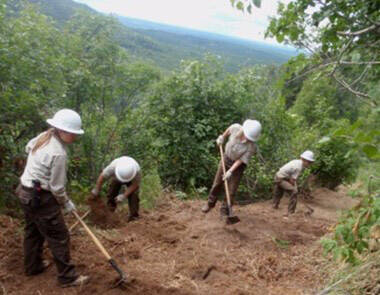If you’re a regular visitor to the trails, cabins and campgrounds of the Kenai National Wildlife Refuge, chances are you’ve seen a cluster of students wearing brown uniforms with matching hard hats and smartly accessorized with safety goggles, leather gloves and lots of bug dope.
They’re generally dirty, often sweating and usually laughing or singing while working within the public use areas of the refuge. Who are these young people, what are they doing, and why are they laughing and singing? I’d like to introduce you to the Youth Conservation Corps program.
The YCC is a direct descendant of President Franklin Delano Roosevelt’s Civilian Conservation Corps program of the 1930s. This program sought to provide alternative employment for a large segment of the population whose lives were derailed by the Great Depression.
Today, the YCC is perhaps the most well-recognized youth program in the U.S. Fish & Wildlife Service. It has been instrumental in introducing young Americans to resource management and conservation opportunities in National Wildlife Refuges.
The YCC, a federal program, was established in 1971 to accomplish needed conservation work on public lands while providing gainful employment to youth that helps to develop an understanding and appreciation of the nation’s natural environment and heritage. The values of personal responsibility, hard work, education and respect for the environment continue to define the program.
Locally, the first YCC program opened at the Kenai refuge, formerly the Kenai National Moose Range, on June 17, 1974, with 30 youth and six adult leaders. Although crew size and program funding have risen and fallen over the years, the program remains true to its founding principles and original intent.
The refuge believes engaging young people in environmental service projects is an effective and innovative way to provide youth with skills that enhance their employability, protect or restore critical ecosystems, and create a pro-conservation citizenry.
Since its inception, the YCC has continued accomplishing high priority and meaningful conservation projects on the refuge, such as trail maintenance, boardwalk repair, bridge construction, historic cabin restoration, invasive species eradication, habitat protection, wildlife research and facility maintenance.
It would be hard to find a campground, trail, sign or structure on the refuge that hasn’t been maintained, improved or enhanced by the work of YCC crews over the years.
Do you know a local high school student between the ages of 15 and 18 looking for a challenging and rewarding summer job opportunity? The application period for this summer’s YCC program is currently open, and the refuge is looking for a few adventurous individuals who like to work hard in the outdoors and don’t mind getting their hands dirty.
The selection process is a random drawing. It will offer a few lucky students a unique opportunity to work, earn and learn together by completing projects that help protect, preserve and restore the Kenai refuge’s natural, cultural and historic resources. Participants will expand their job and leadership skills, develop personal values and ethics, and an awareness of social, political and environmental issues.
Applications for this summer’s program are available at all local high schools, Alaska Employment Service in Kenai, and the Kenai National Wildlife Refuge Headquarters on Ski Hill Road in Soldotna. Applications will be accepted until April 19.
Participants will receive training in first aid, CPR, hand tool use and bear safety. The pay rate will be $13.50 per hour, and the employment period is June 3 to July 26.
So, what’s the singing and laughing all about? I honestly don’t know. The work is often physically demanding, and the working conditions are not always ideal.
However, I believe something inexplicable occurs when a group of students work collaboratively in a challenging environment, experience being part of something larger than themselves, and complete something meaningful that was once thought impossible.
Belting out a tune with your co-workers in the pouring rain or laughing uncontrollably while being devoured by bugs seems like a natural byproduct. That’s the YCC!
Scott Slavik is a Visitor Services Specialist at Kenai National Wildlife Refuge in Soldotna, Alaska. Follow us on Facebook for additional information from the Refuge http://www.facebook.com/kenainationalwildliferefuge. You can find more information on the refuge at http://kenai.fws.gov or http://www.facebook.com/kenainationalwildliferefuge. The Refuge Notebook is published twice a month, and you can find past Refuge Notebook articles at https://www.fws.gov/kenai-refuge-notebook.

